Shrimps are a vital species in the food chain because most shrimp species become prey for many predators like fish and birds. Fairy shrimps and brine shrimps are popular in the aquarium trade as pets and as food sources.
Some people think that both shrimp species are nothing but the same. But are they? Let’s compare both shrimp types in this article.
Is fairy shrimp the same as brine shrimp?
Jump To
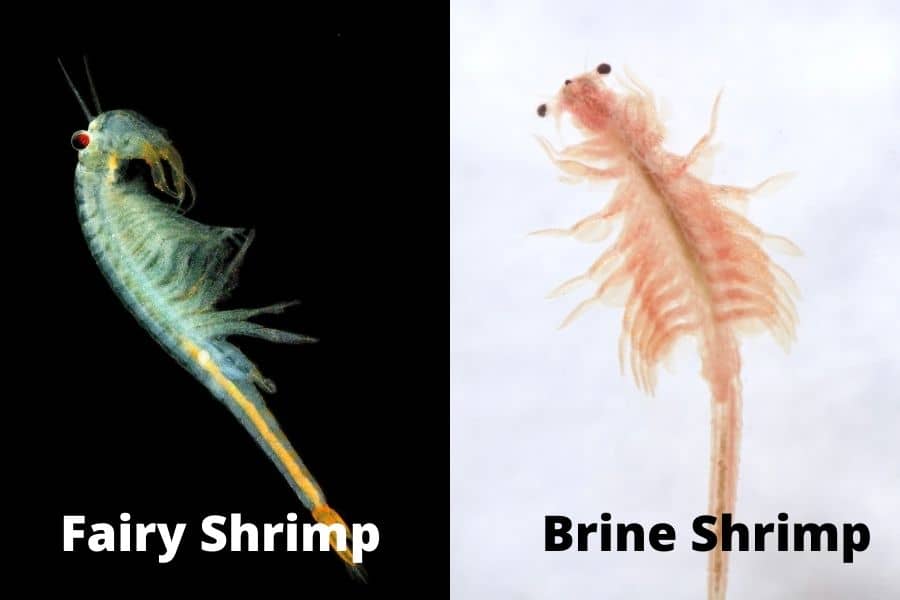
The short answer is no. Though fairy shrimp and brine shrimp may look the same, both shrimps have different names, different colors, and even their habitats are different.
However, they share one thing in common, that they are primary consumers of the food chain. Both shrimp species eat just about anything like plants, algae, bacteria, and many other tiny organisms.
In addition, both species are small enough to get eaten by small fish. Hence they are popular among fish keepers.
However, fairy shrimp are endangered species, and they are somehow hard to culture in captivity for food. On the other hand, brine shrimps are extremely easy to culture in captivity.
Hence they have become one of the primary sources of live food in the aquarium industry.
Fairy Shrimp Vs. Brine Shrimp differences
Though fairy shrimps look so much like a large version of brine shrimp, if you observe carefully, you’ll see that there are several differences between fairy shrimp and brine shrimp.
Different Scientific Names
Both shrimp have different scientific names because both of them are scientifically diverse species. Fairy shrimp’s scientific name is Anostraca, while brine shrimp’s scientific name is Artemia.
Different Habitats
Fairy shrimp’s native waters are in cold lakes and other lakes around the world, while brine shrimp lives in saltwater lakes.
Different Sizes
Both shrimp may look the same but, fairy shrimp are slightly bigger than brine shrimp. Fairy shrimp’s length is about half an inch to one inch, while brine shrimp only grows up to 0.3 to 0.5 inches long.
Different Water Conditions
When it comes to water parameters, both shrimps require different water parameters. Fairy shrimp need freshwater with a pH level of 7.0 to 7.6, while brine shrimp need saltwater with a pH level of 7.5 to 8.0.
| Differences | Fairy Shrimp | Brine Shrimp |
|---|---|---|
| Scientific Name | Anostraca | Artemia |
| Habitat | cold lakes along with other lakes around the world | saltwater lakes |
| Size | ½-1 inches | 0.3 – 0.5 inches |
| Water Condition | freshwater with a pH level of 7.0 to 7.6 | saltwater with a pH level of 7.5 to 8.0 |
Fairy Shrimp
What Is Fairy Shrimp
Fairy shrimp is one of the four orders of crustaceans in the class Branchiopoda. Their scientific name is Anostraca, and there are about 300 species of fairy shrimps across the world.
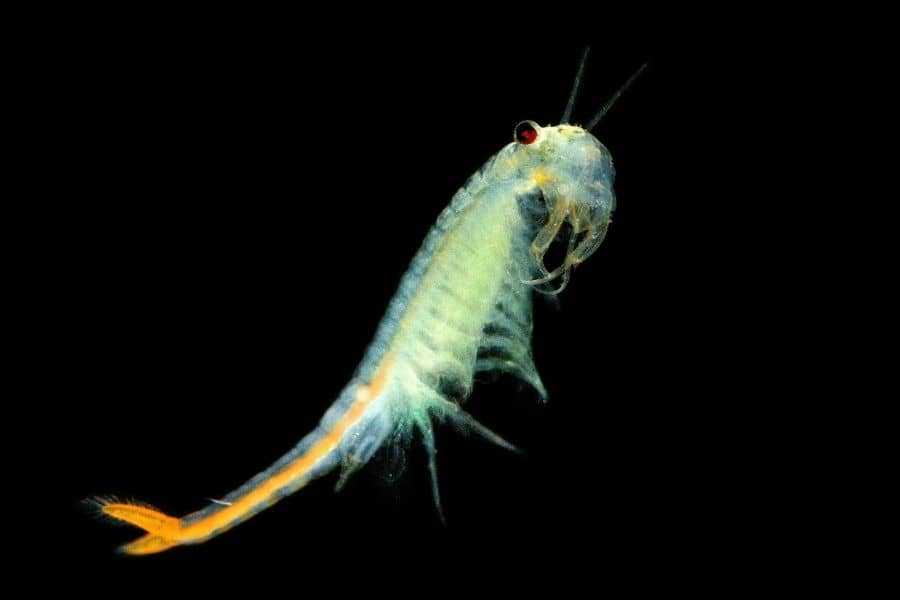
Most of those species have 20 body segments, have 11 pairs of leaf-like phyllopodia (swimming legs), and don’t have a carapace in their body.
Fairy shrimp’s usual mature size is around 0.24 to 0.98 inches (6–25 mm). In exceptional cases, they grow up to 6.7 inches (170 mm ) long. Fairy shrimp’s life cycle lasts only a couple of weeks, but its history dates back to the Cambrian era (about 5oo+ million years ago).
Fairy shrimp’s original population was in oceans. However, their habitats eventually changed to temporary freshwater habitats because of evolving predators.
Related: Amano shrimp vs. Ghost shrimp 7 Differences & Similarities With Images
Related: Do Amano Shrimp Eat Algae? 14 Things You Should Know
Also, see: Cherry Shrimp Babies Care | List of Things You Should Consider
Also, see: Crystal Red Shrimp Care | Complete Guide|
How Do You Identify Fairy Shrimp?
Recognizing fairy shrimps is easy because of their unique features and behavior. Fairy shrimps have stalked eyes, orange, reddish, bronze, or bluish coloration, and have 11 pairs of legs, which are called phyllopods.
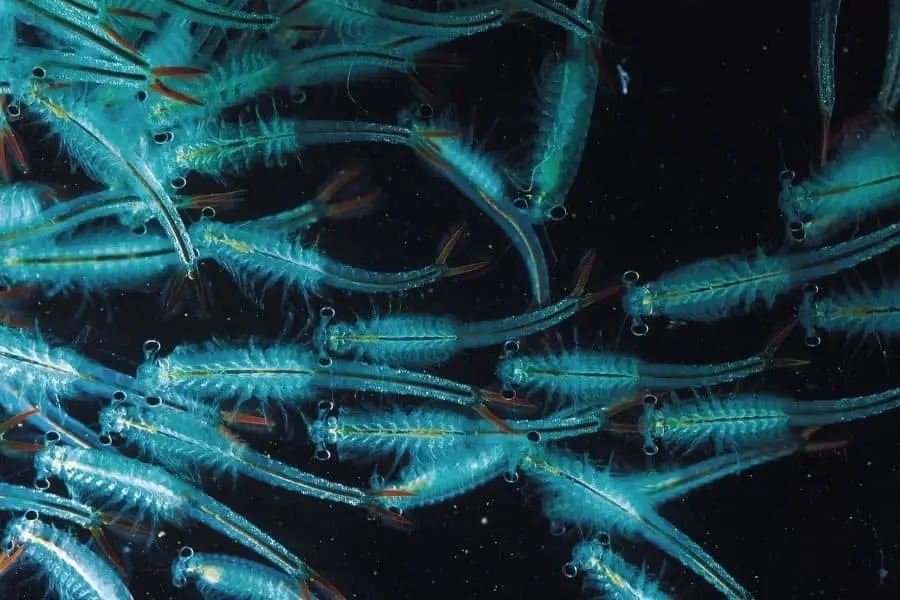
They use these phyllopodia for swimming, and they have an “upside-down” swimming behavior. In addition, fairy shrimps don’t have a carapace.
What Do Fairy Shrimp Eat
Fairy shrimps feed on just about anything that fits in their mouth. From decaying plants and animals to tiny live animals, they can eat anything. Some of their food includes,
- Algae
- Protozoa
- Bacteria
- Rotifers and
- Detritus
How Long Do Fairy Shrimp Live
Fairy shrimps have a very short life span. They live for about six to eight weeks after hatchling from the cysts. However, fairy shrimp cysts can survive for decades, possibly even centuries.
Fairy shrimps have four stages in their life cycle. The cyst stage is dormant until the eggs meet satisfying conditions. The cysts hatch in the late winter or early spring when the surroundings fill with water.
When the eggs hatch, well-developed larvae called “metanauplii” comes. The larvae take around one to two weeks to mature.
The adult life cycle lasts only one to three weeks. When the water of the pool dries out, fairy shrimps die. However, their eggs remain alive until the pool fills up with water again.
Fairy Shrimp Eggs
Fairy shrimp eggs are called cysts. After fertilization, these cysts settle in the bottom of the pool. At there, the cysts enter a state of diapause. These dormant eggs can withstand any environmental change for years until they receive enough water to hatch.
Scientists believe that these cysts can stay dormant for centuries to keep the species alive—the eggs hatch when cysts meet with some water and feel that the water will last for long.
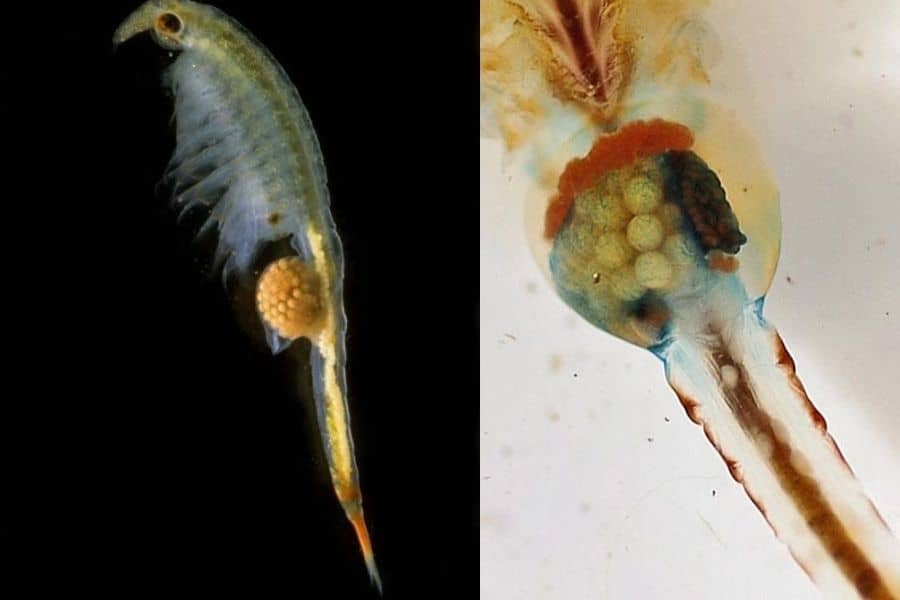
How To Hatch Fairy Shrimp Eggs
Fairy shrimp eggs are available to buy online time by time. You will receive eggs as capsules or in a coffee filter, and you need spring water to hatch the eggs. Avoid tap water as it contains chlorine and other chemicals that are toxic to fairy shrimps.
Instead, put some spring water in a clear glass container. Then gently dump the “dust” in the capsule or coffee filter into the container. Around 3g of this dust contains more than 250000 fairy shrimp eggs.
The eggs will immediately begin to absorb water—fairy shrimp eggs hatch between 10°C and 17°C. The baby shrimp will come out of the cysts after about 24 to 48 hours. Sometimes, it will take shorter or longer than that, depending on the conditions.
These “metanauplii” are very tiny that you may not see them at first. One way to see them is to dim the lights and shine a flashlight into the pan’s side.
They are “phototropic,” which means they are drawn to bright lights. If you leave the flashlight on for a few minutes, the baby shrimp will swim toward it. At this stage, a magnifying glass is handy for viewing them.
Where Do Fairy Shrimp Live
Fairy shrimps live on seasonal ponds and lakes, cold lakes, and other temporary freshwater pools. You can find fairy shrimps almost everywhere as around 300 species of fairy shrimps live around the world. They often hatch in rainy seasons and die when the temporary lakes dry off.
Can you breed fairy shrimp?
Yes. You can breed fairy shrimps if they survive until they mature. The reproduction will happen when they reach adulthood.
Once the female fairy shrimp grow big enough, they make eggs right away. The female shrimp store these eggs in a cigar-shaped pouch inside their abdomen.
Male shrimp always look for a suitable female. When they meet each other, the male shrimp quickly fertilize the eggs and swim away.
When the eggs are fertilized, the eggs change the color from transparent to pale tan color. Further, they get larger.
The female shrimp push out the fertilized eggs from her pouch. Then the eggs sink to the bottom of the pan. The embryos inside the eggs grow for about a day or two until they reach 4000 cells.
Then they shut down and become dormant. The eggs won’t hatch until they’ve been thoroughly dried, chilled, and re-wetted.
How To Store Fairy Shrimp Eggs
The eggs dry out when you remove the bottom pan from water. You can store these eggs in a tightly sealed container once the eggs are dried out completely. The container should be moisture-free. You can keep this container for about a year at room temperature.
Brine Shrimp
What is Brine Shrimp
Brine shrimp, or Artemia, is a genus of aquatic crustaceans. They are distributed worldwide in saltwater lakes but not in oceans. Brine shrimps can live in waters with high salinity up to 25%, which helps them survive the predators such as fish.
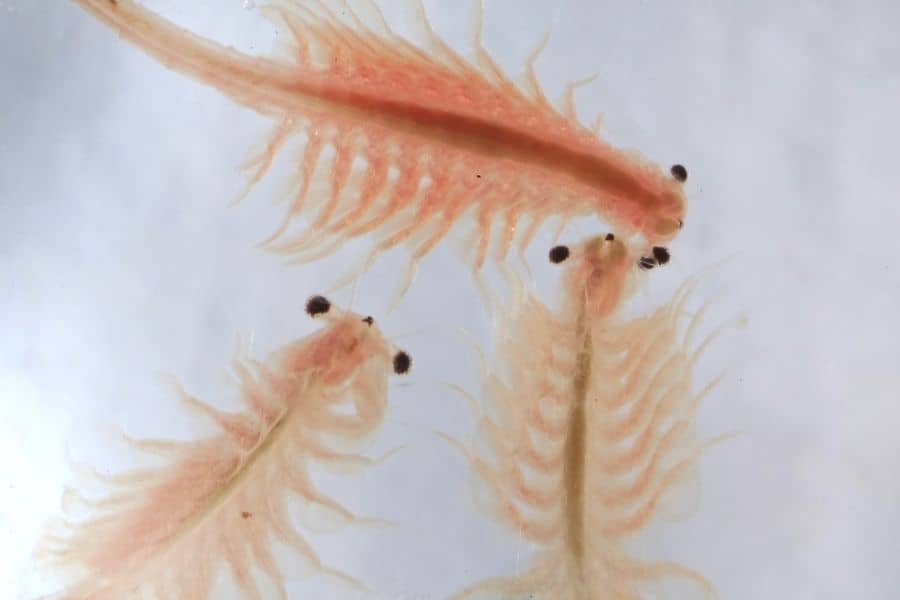
Artemia range in color from pale green, to red, to semi-transparent grey. Brine shrimps that live in very salty water have red color in their body.
They measure up to 15 mm (0.6 inches) in length, with a discrete head with a nauplius (larval) eye and stalked compound eyes, a slender abdomen without appendages, and a thorax bearing a series of leaf-like limbs.
Brine shrimps usually swim in an upside-down position by rhythmically beating their legs.
What Do Brine Shrimp Eat
Brine shrimp in the wild eat microscopic planktonic algae. Brine shrimp are non-selective continuous filter-feeders that eat anything in the correct particle size (between 5 and 50 microns).
They need constant feeding and will do best with natural food like algae and bacteria. You can also feed them with yeast, wheat flour, soybean powder, or egg yolk.
How Long Do Brine Shrimp Live
Under ideal conditions, brine shrimp can live for up to 6 months. However, the baby brine shrimp would take only eight days to mature and begin reproduction and breed at a rate of up to 300 nauplii or cysts every four days.
Brine Shrimp Eggs
You can buy Brine Shrimp eggs at pet stores in sealed, dry containers. In extreme water conditions, such as low oxygen level or high salinity above 150%, female brine shrimp produce the eggs with a chorion coating in brown color.
These eggs are called cysts and are metabolically inactive. They can remain in total stasis for two years while in dry oxygen-free conditions, even at extreme temperatures.
When these cysts meet briny (salt) water, the eggs hatch within few hours. When nauplius larvae first hatch, they are less than 0.4 mm long.
How To Hatch Brine Shrimp Eggs
Hatching brine shrimp eggs is an easy process, but raising brine shrimp is somehow tricky. If you want to harvest nauplius for your fry, you should use a 2-Liter standing cone, an Imhoff cone, or an inverted soda bottle.
Otherwise, any transparent container will work fine. Next, add salt water into your container. The salinity should be 25ppt.
If you are unsure about the salinity, just mix one teaspoonful of aquarium salt with one quart of water. Avoid using tap water as it has chlorine and other toxic chemicals for brine shrimp. The pH level should be pH8.0 or higher.
The optimum water temperature for hatching eggs is 80-82°F (26-28°C). Once you correct these optimum water conditions, you can pour one cap of brine shrimp eggs into the container. It will take around 24 – 36 hours for the eggs to hatch.
Where Do Brine Shrimp Live
Brine shrimps live in saltwater lakes around the world. They generally live in lakes with high salinity where predators can not survive due to the high salinity. Although brine shrimp live in saltwater, they don’t live in oceans.
Can You Breed Brine Shrimp?
Breeding brine shrimp is easy when they have favorable conditions. However, many brine shrimp will not survive until they mature in captivity.
People culture Brine shrimp because the larvae are an excellent food source for aquarium fish fry. Hence, people only raise brine shrimp for a day or two to harvest baby brine shrimp.
Brine shrimp eggs are incredibly inexpensive as the harvesting companies harvest brine shrimp cysts from natural saltwater lakes. So, there is no need for the reproduction of brine shrimp in captivity.
